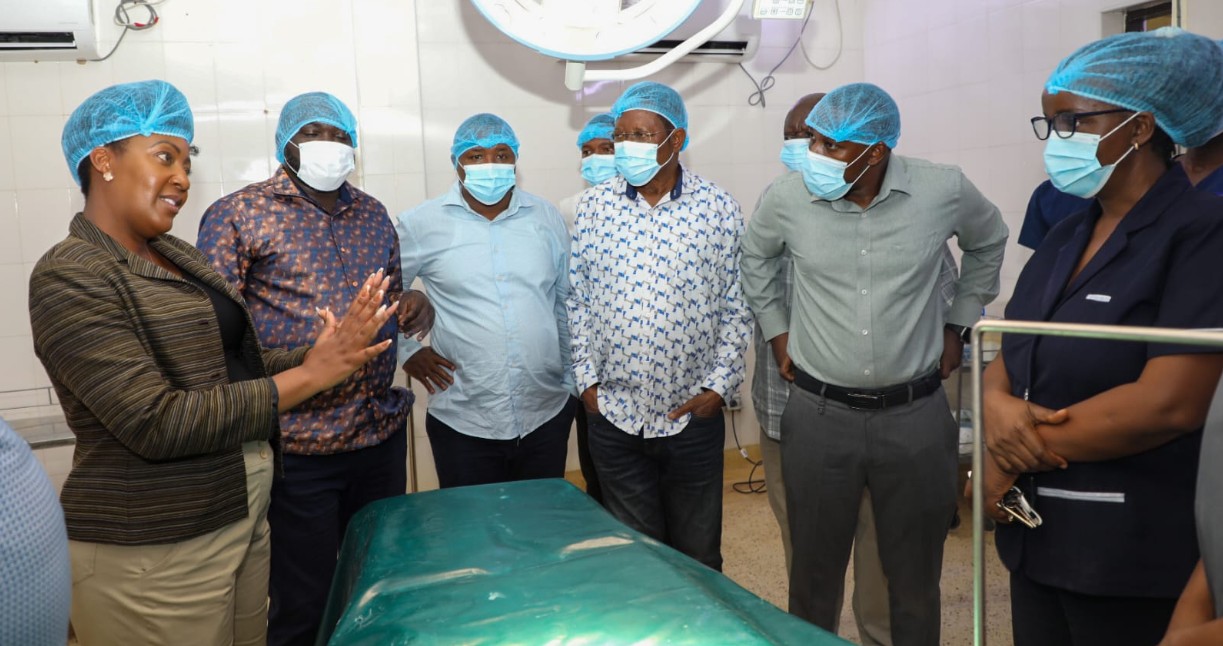From near death to lifesaver: How surviving postpartum haemorrhage inspired Kenyan midwife’s mission

In Kenya, ten women die every day from postpartum haemorrhage—lives lost in delivery rooms and hospital wards, their names fading into statistics.
"Can I just see my baby? Just once... just to hold him before I go."
Those were the faint, desperate words whispered by Eunice Atsali as she drifted in and out of consciousness, lying in a pool of her own blood after what was supposed to be a routine Caesarean section.
More To Read
- Kenya losing 10 mothers daily to preventable postpartum haemorrhage, experts warn
- Hidden risks of over-the-counter drugs in early pregnancy
- Nairobi teen faces childbirth alone after being denied care for lacking ID, SHA
- Maternal health: MoH approves use of two life-saving drugs in all health facilities
- UN says 260,000 women died at childbirth in 2023 despite advances in healthcare
- Explainer: How Kenya is struggling to curb maternal, newborn deaths amid gaps in healthcare
A trained midwife, Atsali knew exactly what was happening—and how dangerously close she was to dying from postpartum haemorrhage (PPH).
Atsali is no ordinary health worker. She is a midwife, a teacher of midwifery and nursing, and the secretary of the Midwifery Association of Kenya. She has dedicated her life to supporting mothers through pregnancy and childbirth.
But in that harrowing moment—afraid, helpless, and haemorrhaging—she was not the caregiver. She was the patient.
Her second child, now 16, had been born prematurely. Given that her first child, now 18, had also been delivered via Caesarean section, she had scheduled a planned CS at a major referral hospital. The surgery itself took only 15 minutes. But during recovery, she sensed something was wrong.
"I woke up and realised I was lying in warm fluid. I immediately knew it was blood."
Blood pressure plummeting
She alerted the nurse. Her blood pressure was plummeting, and within moments, the medical team rushed to intervene. Blood was ordered, and her uterus was checked—it wasn’t contracting properly. The bleeding continued. Her body was going into postpartum haemorrhage, one of the most dangerous complications after childbirth.
"As a midwife, I could see it happening in real time. But I was the one on the bed. And I couldn't stop it."
Then came the chilling diagnosis from a doctor:
"She is having VIC."
A clotting disorder had set in—a state where the body can no longer form clots to stop bleeding. It confirmed her worst fears: her life was slipping away.
The team manually compressed her uterus to trigger contraction, and a potent drug, Prostaglandin F2-alpha (PDF2), was injected directly into it.
"That drug can save your life. But it can also shut down your system instantly. I collapsed almost immediately."
Lost consciousness
She lost consciousness. When she woke up, she was in critical condition—head lowered, legs elevated, and multiple IV lines pumping fluids into her body. She had received six units of blood. What began as a routine surgery had turned into a six-hour emergency that nearly claimed her life.
"I remember thinking, this is how many women die—in silence, and in blood."
Somehow, she survived—her body battered, her blood drained, trembling from the trauma, but still breathing. Still alive.
She was one of the lucky ones.
In Kenya, ten women die every day from postpartum haemorrhage—lives lost in delivery rooms and hospital wards, their names fading into statistics. Another twenty die from other complications related to childbirth—quiet tragedies unfolding in homes and clinics unequipped to save them.
Bold choice
After her recovery, Atsali made a bold choice. She returned to school to pursue a master’s degree in midwifery, focusing specifically on PPH. What she learned only strengthened her resolve: too many women were dying simply because health systems were unprepared.
"It wasn't just me. My story is the story of thousands of women. The only difference is, I lived."
She began to mobilise resources, raise awareness, and train healthcare providers. She contributed to national guidelines on maternal and newborn care and helped develop programmes supporting midwives across Kenya in the management of PPH.
Heat-stable carbetocin
One of her proudest achievements was advocating for the use of heat-stable carbetocin—a drug that controls bleeding after childbirth. Unlike oxytocin, it does not require refrigeration, making it ideal for rural areas.
"When we started, only 10 counties had this drug. Now, every county does."
She also helped introduce the EMOTIVE Bundle—a set of life-saving interventions for PPH response—through national training and mentorship programmes.
Yet one memory continues to haunt her: blood... and the presence of trained hands.
She knows she survived because six units of blood were available—and because skilled healthcare professionals were at her side when it mattered most.
Deaths
Many women are not as fortunate. Some bleed to death because there is no blood available for transfusion. Others die because the person attending to them is untrained, overwhelmed, or lacks the right tools.
And too many are unaware of the danger they’re in—because no one told them what to ask, what to expect, or what warning signs to watch for.
She calls for urgent reforms in hospitals across Kenya and urges women to become active participants in their own care—to walk into clinics and maternity wards not just with hope, but with knowledge, and the power to choose safety.
Dr Richard Mogeni, an obstetrician and gynaecologist at Moi Teaching and Referral Hospital and head of the Maternal Medicine Department, explains that postpartum haemorrhage is a serious condition involving excessive bleeding after childbirth.
It can occur immediately after delivery or even weeks later, up to six weeks postpartum. PPH remains one of the leading causes of maternal death globally, accounting for nearly 40 per cent of such fatalities.
 Dr Richard Mogeni, obstetrician and gynaecologist at Moi Teaching and Referral Hospital, explains that postpartum haemorrhage is a life-threatening condition caused by excessive bleeding after childbirth. (Photo: Charity Kilei)
Dr Richard Mogeni, obstetrician and gynaecologist at Moi Teaching and Referral Hospital, explains that postpartum haemorrhage is a life-threatening condition caused by excessive bleeding after childbirth. (Photo: Charity Kilei)
The causes of PPH are varied.
Trauma during delivery is common. For example, a woman expecting a natural delivery may suffer a uterine rupture or tears along the birth canal, leading to severe bleeding.
Retained tissue—where parts of the placenta or membranes remain in the uterus—can also lead to continuous bleeding. Some women have clotting disorders, which make it harder for their blood to clot properly.
Haemoglobin disorders
Conditions such as haemoglobin disorders further reduce clotting factors, complicating recovery. Another cause is premature separation of the placenta, which can result in massive blood loss.
"The most critical cause is uterine atony—when the uterus fails to contract after birth. Without this contraction, blood vessels remain open and bleeding becomes uncontrollable."
To combat PPH, there's a major push to ensure all county hospitals have essential drugs like heat-stable oxytocin, which helps the uterus contract effectively.
Alongside medication, practices such as uterine massage and early breastfeeding support contraction and lower the risk of haemorrhage.
"Heat-stable carbetocin is a must—we must ensure that no mother goes without it, especially in rural areas where cold-chain storage is a challenge."
Trauma-related causes
Dr Mogeni adds that trauma-related causes—like female genital mutilation (FGM) or severe tears—can be particularly dangerous, especially when the birth canal is obstructed.
"Antenatal care helps us monitor mothers and identify those at risk. Losing even a litre of blood during delivery can push a woman to the brink of shock."
He stresses that Caesarean sections must be approached with caution. While generally safe, CS can turn risky when done unnecessarily or by inexperienced hands. Women requesting CS should have clear clinical reasons, and whenever possible, vaginal birth after Caesarean (VBAC) should be encouraged.
"CS is not inherently risky, but it can quickly turn dangerous without blood availability and skilled personnel. Our health system must be ready to support every mother."
One persistent challenge in managing PPH is the inconsistent availability of blood. In many counties, shortages are common, and can be fatal when bleeding is severe. This highlights the urgent need to strengthen blood donation systems and ensure a reliable supply across the country.
"Too many women die because there is no blood when they need it most," he says. "We need stronger blood donation systems and reliable supplies across all counties."
He also points to gaps in clinical decision-making. Delayed or ineffective decisions cost lives. To change this, there must be strong political will and consistent investment in maternal health. He urges women leaders to be vocal advocates for mothers across the country.
According to the World Health Organisation (WHO), postpartum haemorrhage is the leading cause of maternal deaths globally, responsible for around 25 per cent of cases. In Africa, over 100,000 women die from PPH annually, accounting for more than half of all maternal deaths. In Kenya, it affects 8 to 10 per cent of births and claims around ten lives every day. Most of these deaths are preventable—uterine atony alone accounts for 70 to 80 per cent of cases.
Top Stories Today











































